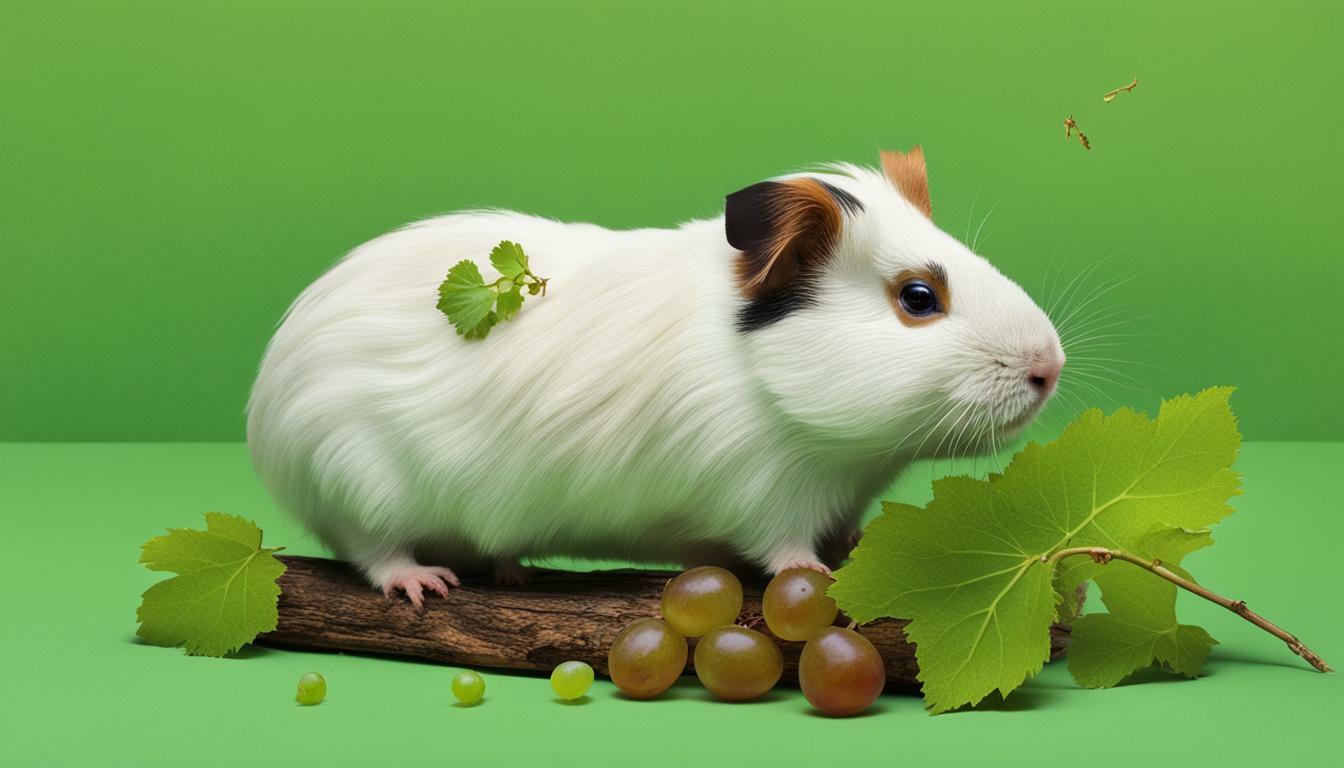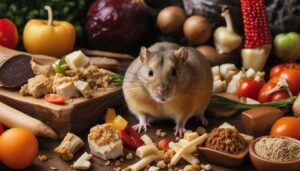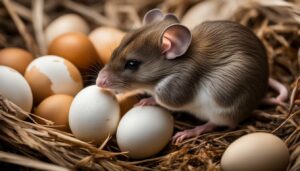Guinea pigs can eat grape stems in moderation as part of their diet. Grape stems provide a good source of fiber, which promotes healthy gastrointestinal bacteria and helps prevent constipation in guinea pigs. However, it’s important to note that grape stems should not be the main source of food for guinea pigs. It’s recommended to limit the intake of grape stems to a small piece or two, once or twice a week. Monitoring the guinea pig’s reaction and adjusting the food if any digestive distress or changes in appetite occur is crucial. Additionally, it’s necessary to wash the grape stems thoroughly to remove dirt and pesticides. Chopping the stems into smaller pieces or removing them altogether can make it easier for guinea pigs to chew. However, it’s essential to be aware of potential risks such as dental problems, digestive issues, and choking hazards when feeding grape stems. It’s also worth noting that grapes should be served fresh and undamaged, and any uneaten food should be removed to prevent spoilage.
Key Takeaways:
- Guinea pigs can eat grape stems in moderation as part of their diet.
- Grape stems provide fiber, which promotes healthy digestion and prevents constipation.
- Limit the intake of grape stems to a small piece or two, once or twice a week.
- Monitor the guinea pig’s reaction and adjust the food if any digestive distress or changes in appetite occur.
- Wash grape stems thoroughly to remove dirt and pesticides before feeding.
Guinea Pig Diet: An Overview
A well-balanced diet is essential for the health and well-being of guinea pigs. These adorable creatures require a variety of nutrients to thrive and lead a happy life. Here is an overview of the key aspects to consider when it comes to their dietary needs.
Dietary Requirements
Guinea pigs have specific nutritional requirements that must be met to ensure their overall health. Their diet should consist primarily of fresh hay, as it provides the necessary fiber for proper digestion and helps wear down their teeth, which continue to grow throughout their lives. Alongside hay, leafy greens such as romaine lettuce, spinach, and kale should be incorporated into their diet, providing them with essential vitamins and minerals.
In addition to hay and leafy greens, guinea pigs require a good source of vitamin C in their diet as they cannot produce it themselves. Include fresh fruits and vegetables rich in vitamin C, such as bell peppers and strawberries, to meet this requirement.
Feeding Guidelines
When feeding your guinea pig, it is important to offer a variety of foods to provide a balanced diet. Aim to introduce new foods gradually to prevent digestive upset. Always ensure that fresh water is available, and avoid feeding them foods that are harmful, such as chocolate, onions, and garlic.
Here is a table summarizing suitable foods for guinea pigs:
| Food Group | Examples |
|---|---|
| Hay | Timothy hay, orchard grass, meadow hay |
| Leafy Greens | Romaine lettuce, spinach, kale, parsley |
| Vitamin C-rich Fruits and Vegetables | Bell peppers, strawberries, oranges, kiwi |
| Pellets | High-quality guinea pig pellets |
Remember, moderation is key when it comes to feeding treats or foods that are higher in sugar content. Too many sugary treats can lead to weight gain and other health issues, so it’s important to offer them sparingly.
By offering a well-balanced diet that meets their nutritional needs, you can ensure that your guinea pig remains happy and healthy for years to come.
Understanding Grape Stems for Guinea Pigs
Grape stems can provide guinea pigs with additional fiber in their diet. Fiber is an essential component of a guinea pig’s nutrition, as it promotes healthy gastrointestinal bacteria and helps prevent constipation. Including grape stems in their diet can be a beneficial way to increase their fiber intake.
However, it’s important to note that grape stems should not be the main source of food for guinea pigs. Instead, they should be fed in moderation, as an occasional treat. Limiting the intake to a small piece or two once or twice a week is recommended to ensure a balanced diet.
When feeding grape stems to guinea pigs, it is crucial to monitor their reaction. Any digestive distress or changes in appetite should be noted, and adjustments to their diet may be necessary. Additionally, it is essential to wash the grape stems thoroughly before feeding them to remove any dirt or pesticides that may be present. To make it easier for guinea pigs to chew, the stems can be chopped into smaller pieces or removed altogether.
Table: Potential Risks Associated with Feeding Grape Stems to Guinea Pigs
| Risks | Considerations |
|---|---|
| Dental Problems | Grape stems may be hard and chewy, potentially causing dental issues. Monitor your guinea pig’s teeth regularly and consult a veterinarian if any problems arise. |
| Digestive Issues | Some guinea pigs may have difficulty digesting grape stems, leading to gastrointestinal discomfort. Pay attention to any signs of digestive distress and adjust their diet accordingly. |
| Choking Hazards | Guinea pigs should not be given large pieces of grape stems to prevent choking. Chop the stems into smaller, manageable pieces to reduce the risk. |
It’s worth noting that grapes should be served fresh and undamaged to ensure optimal nutrition. Any uneaten food, including grape stems, should be promptly removed from the guinea pig’s cage to prevent spoilage.
Moderation is Key
While grape stems can be included in a guinea pig’s diet, it’s crucial to serve them in moderation. Grape stems provide a good source of fiber, which is beneficial for promoting healthy gastrointestinal bacteria and preventing constipation in guinea pigs. However, it’s important to remember that grape stems should not be the main source of food for guinea pigs. Instead, they should be limited to a small piece or two once or twice a week.
It’s essential to closely monitor your guinea pig’s reaction to grape stems. If you notice any digestive distress or changes in appetite, it’s important to adjust their diet accordingly. Guinea pigs have sensitive digestive systems, so it’s crucial to introduce new foods gradually and observe any reactions.
Before feeding grape stems to your guinea pig, it’s necessary to wash them thoroughly to remove any dirt or pesticides. Chopping the stems into smaller pieces or removing them altogether can also make it easier for your guinea pig to chew. However, it’s crucial to bear in mind the potential risks associated with grape stems, such as dental problems, digestive issues, and choking hazards. Always ensure that the stems are prepared and served in a way that minimizes these risks.
| Potential Risks | Preventive Measures |
|---|---|
| Dental problems | Monitor guinea pig’s dental health regularly and consult a veterinarian if any issues arise. |
| Digestive issues | Introduce new foods gradually and observe any changes in your guinea pig’s digestion. |
| Choking hazards | Chop grape stems into smaller, manageable pieces or remove them altogether to prevent choking. |
Additionally, it’s worth noting that grapes themselves should be served fresh and undamaged. Any uneaten food should be promptly removed to prevent spoilage and maintain a hygienic environment for your guinea pig. By following these guidelines and ensuring moderation, you can safely incorporate grape stems into your guinea pig’s diet and provide them with a varied and balanced nutritional intake.
Monitoring Your Guinea Pig’s Reaction
It’s essential to monitor your guinea pig’s reaction when introducing grape stems into their diet. While grape stems can provide some nutritional benefits, not all guinea pigs may tolerate them well. Some guinea pigs may experience digestive distress, such as bloating or diarrhea, after consuming grape stems.
To ensure the health and well-being of your guinea pig, it’s important to start with a small piece or two of grape stems and observe their response. If your guinea pig shows any signs of discomfort or changes in appetite, it’s recommended to discontinue feeding them grape stems and consult a veterinarian.
If your guinea pig tolerates grape stems well, you can continue to include them in their diet, but in moderation. Remember, grape stems should not be the main source of food for guinea pigs. They should be viewed as a treat or occasional addition to their regular diet. Offering a variety of fresh vegetables, hay, and guinea pig pellets is still crucial for their overall nutrition.
| Potential Signs of Digestive Distress: |
|---|
| – Bloating |
| – Diarrhea |
| – Lack of appetite |
| – Abdominal discomfort |
By closely monitoring your guinea pig’s reaction and adjusting their diet accordingly, you can ensure that they receive the necessary nutrients while avoiding any potential health issues. Always consult with a veterinarian if you have any concerns or questions regarding your guinea pig’s diet.
Preparing Grape Stems for Guinea Pigs
Before feeding grape stems to guinea pigs, it’s important to properly prepare them to ensure safety and cleanliness. Here are some guidelines to follow:
Washing the Grape Stems
Start by washing the grape stems thoroughly to remove any dirt, pesticides, or residue that may be present. This can be done by rinsing them under cool running water and gently scrubbing them with a soft brush, if necessary. Ensuring the stems are clean helps prevent any potential health risks for your guinea pig.
Chopping into Smaller Pieces
Grape stems can be quite long and fibrous, which can make them difficult for guinea pigs to chew and digest. To make it easier for them to consume, you can chop the stems into smaller, more manageable pieces. This can be done using a sharp knife or kitchen scissors. Alternatively, you can remove the stems altogether and only feed the grape fruits to your guinea pig.
Feeding in Moderation
While grape stems can provide some nutritional benefits, they should not be the main source of food for guinea pigs. It’s important to feed them in moderation to prevent any potential digestive issues. Limit the intake of grape stems to a small piece or two once or twice a week, and observe your guinea pig’s reaction. If you notice any changes in their appetite or digestive distress, adjust their diet accordingly.
By following these preparation guidelines, you can ensure that the grape stems you feed to your guinea pigs are safe, clean, and easier for them to eat and digest.
| Preparation Steps: |
|---|
| Wash the grape stems thoroughly to remove dirt and pesticides. |
| Chop the stems into smaller, more manageable pieces. |
| Limit the intake to a small piece or two once or twice a week. |
Potential Risks and Considerations
While grape stems can be included in a guinea pig’s diet, there are some risks to be aware of. One of the main concerns is dental problems. Guinea pigs have continuously growing teeth, and chewing on hard materials like grape stems may contribute to overgrowth or dental misalignment. It’s crucial to provide your guinea pig with appropriate chew toys and monitor their dental health regularly.
Another potential risk is digestive issues. Grape stems contain a high amount of fiber, which is beneficial for gut health. However, excessive consumption of fiber can lead to gastrointestinal discomfort, such as gas or bloating. It’s important to introduce grape stems gradually and in moderation, monitoring your guinea pig’s digestion and adjusting their diet accordingly.
Choking hazards are also a concern when feeding grape stems. Guinea pigs have a small throat and can struggle with swallowing large or fibrous pieces. To minimize the risk, it is recommended to chop the stems into smaller, easily manageable pieces. If your guinea pig shows signs of difficulty while eating or becomes distressed, remove the grape stem immediately.
| Potential Risks: | Considerations: |
|---|---|
| Dental problems | Monitor dental health regularly, provide appropriate chew toys |
| Digestive issues | Introduce grape stems gradually, monitor digestion, and adjust diet as needed |
| Choking hazards | Chop grape stems into smaller pieces, remove immediately if any signs of distress |
It’s worth mentioning that moderation is key when incorporating grape stems into your guinea pig’s diet. While they can provide some nutritional benefits, they should not be the main source of food. Remember to wash grape stems thoroughly before feeding to remove any dirt or pesticides. Additionally, ensure that grapes are fresh and undamaged. Removing any uneaten food promptly can prevent spoilage and maintain your guinea pig’s health.
Fresh and Undamaged Grapes
When offering grapes to guinea pigs, it’s crucial to serve them fresh and undamaged. Guinea pigs thrive on a diet that is rich in fresh fruits and vegetables, and grapes can be a tasty treat for them. However, it’s important to ensure that the grapes are in good condition before feeding them to your furry friends.
To maintain the highest quality of grapes, choose ones that are firm and plump, with no signs of wrinkling or soft spots. Avoid grapes that have mold or discoloration. When serving grapes to guinea pigs, always wash them thoroughly to remove any dirt, pesticides, or potential contaminants. It is also a good practice to remove the stems and any seeds, as they can pose a choking hazard and may be difficult for guinea pigs to digest.
Feeding guinea pigs fresh and undamaged grapes not only ensures their safety but also provides them with a delicious snack that is packed with vitamins and minerals. Grapes are a good source of vitamin C, which is essential for guinea pigs as they cannot produce this vitamin on their own. Additionally, grapes contain natural sugars that can provide a quick burst of energy for these active animals.
Remember to always offer grapes in moderation, as excessive consumption can lead to digestive issues. Remove any uneaten grapes from the guinea pig’s enclosure to prevent spoilage. By following these guidelines, you can safely incorporate fresh and undamaged grapes into your guinea pig’s diet, providing them with an enjoyable and nutritious treat.
| Nutritional Value of Grapes | ||
|---|---|---|
| Vitamin C | Fiber | Natural sugars |
| Antioxidants | Water content |
Conclusion
Guinea pigs can safely eat grape stems as part of a well-balanced diet, but it’s important to do so in moderation and monitor their response. Grape stems are a good source of fiber, which promotes healthy gastrointestinal bacteria and prevents constipation in guinea pigs. However, they should not be fed as the main source of food for guinea pigs.
It is recommended to limit the intake of grape stems to a small piece or two once or twice a week. This allows guinea pigs to enjoy the nutritional benefits without overwhelming their digestive system. It’s crucial to pay attention to your guinea pig’s reaction after consuming grape stems and make adjustments if any digestive distress or changes in appetite occur.
Grape stems should be washed thoroughly before feeding to remove dirt and any potential pesticides. Additionally, chopping the stems into smaller pieces or removing them altogether can make it easier for guinea pigs to chew and digest. However, it’s essential to be aware of potential risks such as dental problems, digestive issues, and choking hazards associated with feeding grape stems. Always prioritize the safety and well-being of your guinea pig when introducing new foods into their diet.
Remember, grapes should be served fresh and undamaged to ensure they provide the most nutritional value. Any uneaten food should be promptly removed from the guinea pig’s enclosure to prevent spoilage and maintain a clean and healthy environment. By following these guidelines and being attentive to your guinea pig’s dietary needs, you can safely incorporate grape stems into their diet as a nutritious and enjoyable treat.
FAQ
Can guinea pigs eat grape stems?
Yes, guinea pigs can eat grape stems in moderation.
Are grape stems a good source of fiber for guinea pigs?
Yes, grape stems contain fiber which promotes healthy gastrointestinal bacteria and prevents constipation in guinea pigs.
How often should I feed grape stems to my guinea pig?
It is recommended to limit the intake of grape stems to a small piece or two once or twice a week.
What precautions should I take when feeding grape stems to my guinea pig?
It’s important to monitor your guinea pig’s reaction and adjust the food if any digestive distress or changes in appetite occur. Wash the grape stems thoroughly before feeding to remove dirt and pesticides. Chopping the stems into smaller pieces or removing them altogether can make it easier for guinea pigs to chew.
Are there any risks associated with feeding grape stems to guinea pigs?
Yes, there are potential risks such as dental problems, digestive issues, and choking hazards. It’s important to be aware of these risks and monitor your guinea pig’s health.
What should I do with uneaten grapes or grape stems?
Grapes should be served fresh and undamaged, and any uneaten food should be removed to prevent spoilage.




